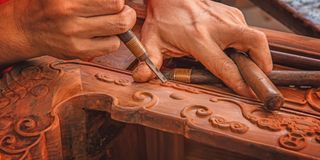Sapele: An affordable, sustainable substitute to the real mahogany

Crafting mahogany furniture. Sapele mahogany is a more affordable and sustainable substitute of the real mahogany. And like the real mahogany, it is used in making high-end furniture among other items.
What you need to know:
- In Kenya, it is found in Kakamega forest, the country’s only tropical rainforest. Situated in Kakamega and Nandi counties, it was once part of the Congo Basin forests that spanned Africa from west to east.
- According to the Centre for International Forestry Research (CIFOR) and World Agroforestry Centre, tree planters must select a seed that suits the site and supports the trees’ multiple functions.
- Demand for Sapele has increased in recent years due to the genuine mahogany becoming listed by CITES as an endangered species.
- For centuries, Africans have used Sapele in traditional medicine for the treatment of several illnesses.
Entandrophragma cylindricum, also known as Sapele or Sapele mahogany, is native to tropical Africa. It is commonly found in rainforests of Ivory Coast, Ghana, Nigeria, Cameroon, Uganda, Tanzania and Kenya.
It grows in altitudes of 1,600m above sea level and annual rains of more than 1,200mm.
In Kenya, it is found in Kakamega forest, the country’s only tropical rainforest. Situated in Kakamega and Nandi counties, it was once part of the Congo Basin forests that spanned Africa from west to east. It contains many species that are to be found nowhere else in Kenya, Sapele being one of them.
The name Sapele comes from the city of Sapele in Delta state, Nigeria, where many of the trees grow.
The name of the city itself is an Anglicisation of the local Urhobo word Uriapele, commemorating a local deity.
The British established a timber business there in the 19th century that thrived on the export of this tree.
Benefits
According to the Centre for International Forestry Research (CIFOR) and World Agroforestry Centre, tree planters must select a seed that suits the site and supports the trees’ multiple functions.
These are as a source of food, medicine, livelihood, habitat for wildlife and protection for air, water and soil quality.
“A carefully considered tree-planting strategy is essential to protecting the world’s soil, biodiversity and carbon sinks,” says CIFOR director-general Robert Nasi.
Sapele mahogany is a more affordable and sustainable substitute of the real mahogany.
Demand for Sapele has increased in recent years due to the genuine mahogany becoming listed by CITES as an endangered species.
And like mahogany, it is used in making high-end furniture, cabinetry, doors and windows, musical instruments, boats, flooring, panelling and various outdoor and indoor construction.
In musical instruments, it is used for the back and sides of acoustic guitar bodies, as well as the bodies of electric guitars, harps and percussion instruments.
Even though Sapele boasts many of the premium attributes found in mahogany, its cost is about half that of genuine mahogany.
Medicine
For centuries, Africans have used Sapele in traditional medicine for the treatment of several illnesses.
One study carried out by scientists from the University of Yaounde, Cameroon and Stellenbosch University of South Africa established its medicinal properties.
It was titled ‘Phytochemistry and pharmacology of the genus Entandrophragma over the 50 years from 1967 to 2018: a “golden” overview’ and published in the Journal of Pharmacy and Pharmacology in 2018.
In the study, Gervais Mouthe Happia, Bonaventure Tchaleu Ngadjui, Ivan Robert Green, et al reviewed a large range of phytochemicals from the tree and their pharmacological potentials.
They found out the extracts of some species support the traditional uses of this tree in folk medicine. Some compounds revealed promising anti-plasmodial and anti-inflammatory activities and deserve further attention for new drug discovery.
Threats
Although supplies of Sapele are still plentiful, in recent years it is starting to get vulnerable.
Increased levels of commercial exploitation have seen its conservation status change over the past several decades.
Today, it is ranked on the International Union for the Conservation of Nature (IUCN) red list as a vulnerable species, due to the loss of more than 20 per cent of total tree population over the past three generations of growth.
Propagation
The main method of propagation is through seeds. They should be planted in sand beds, which should be kept moist by watering.
Germination takes between 10 and 20 days and they can be planted when they are 20cm tall.
They are fast-growing trees and mature in 25 years but can live for up to 350 years.




